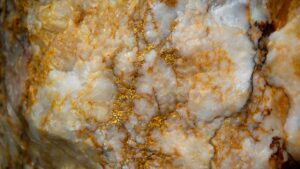New Age uncovers more hints of gold in New Zealand

Pic: Via Getty Images
New Age is itching to get a crack on further exploring its assets across the pond after expanding the gold potential of its Lammerlaw project in Otago, New Zealand.
A review of newly reprocessed legacy geophysical data over all its Otago permits has highlighted compelling new gold targets in under-explored locations.
If that wasn’t reason enough for New Age Exploration (ASX:NAE) to get excited, portable XRF analysis of arsenic results from additional auger, float and rock chip sampling has extended arsenic-gold geochemical trends delineated by field campaigns carried out in November 2020 and February 2021.
Assays are also pending for samples collected in May 2022 while an application submitted to New Zealand Petroleum & Minerals for an Extension of Duration for Lammerlaw Prospecting Permit PP60544 has been granted, allowing for continued surface exploration until 26 November 2023.
The company intends to continue using proven targeting methodologies along a 25km prospective structural corridor under Permit PP60544 and Exploration Permit EP60807.
“The New Zealand gold portfolio continues to advance and mature with more exciting prospects emerging with each stage of the exploration,” executive director Joshua Wellisch said.
“All the projects represent substantial opportunities for new gold discoveries within the well-endowed Otago region NZ.”
Proven gold province
The Otago region hosts the Central Otago Schist Belt, which has proven gold endowment as highlighted by Santana Minerals’ recent discoveries at the Bendigo-Ophir Gold Project as well the world class Macraes gold mine which is owned and operated by Oceana Gold.
New Age believes that its Lammerlaw project could potentially host structurally controlled orogenic gold mineralisation similar to the bulk tonnage Macraes and Bendigo-Ophir deposits, as well as high-grade quartz lode gold systems seen elsewhere in Otago.
Notable prospects are the antimony mine that was discovered in the late 1870s with intermittent mining occurring between 1880 and 1900, the Bucks prospect which hosts a well defined 1.9km geochemical trend, the Fulton’s prospect that has been worked extensively for alluvial gold and tungsten, and the Bella Lode that was discovered in the 1890s and worked intermittently until 1900.
Work has indicated that Fulton’s and Bella sit along the same structure.
Further exploration at Lammerlaw will include broadly spaced auger soil sampling lines within PP60544 and prospecting work to extend strike length of mineralised trends within EP60807.
Due to the lack of outcrop, next steps will include trenching across mineralised trends to understand widths and controls on gold mineralisation. Results will be ranked against other Otago projects to determine the best targets for drill testing.
This article was developed in collaboration with New Age Exploration, a Stockhead advertiser at the time of publishing.
This article does not constitute financial product advice. You should consider obtaining independent advice before making any financial decisions.
Related Topics

UNLOCK INSIGHTS
Discover the untold stories of emerging ASX stocks.
Daily news and expert analysis, it's free to subscribe.
By proceeding, you confirm you understand that we handle personal information in accordance with our Privacy Policy.








